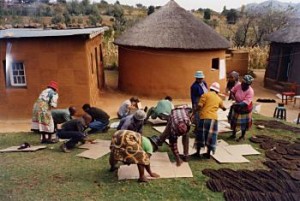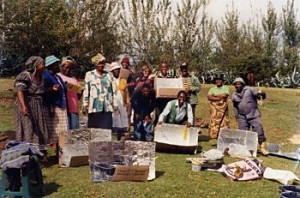
Report on Peace Corps Initiated Solar Oven Project in Lesotho, Southern Africa
Nancy Bailey and myself were U.S. Peace Corps Volunteers in Lesotho, Southern Africa from May 2001 — July 2003. Lesotho is a high-altitude country where winters can be bitterly cold and deforestation and soil erosion are major environmental problems. It is, happily, also a country with many sunny days and a growing awareness of fuel shortage problems. Most rural families cannot afford the Propane stoves and heaters used in the towns and thus use cow dung patties as fuel for cooking and warmth. Trees are scarce in all parts of the country, particularly in the mountains. Burnable fuel is scoured from shrubs, dried out Aloe plants, dung of grazing animals and even the rootstalks of corn and other harvested crops. In a country already suffering from severe soil erosion, soil nutrient depletion and deforestation, the future impacts of these continued practices are obvious and frightening.
Nancy and I were located in villages approximately 5km. apart in the northern district of Butha-Buthe. During our service, we each received information on solar cooking / cooker construction from our friends in the US. We received building instructions for several different types of solar cookers obtained from the Solar Cooking International website (www.solarcooking.org), as well as a CooKit solar cooker and various cooking instructions from a friend at Sierra Solar in Grass Valley, CA (www.sierrasolar.com). Nancy and I began to experiment with these at our homes — using the CooKit and also a cardboard box cooker built using the SCI instructions. We experimented with cooking different types of food, optimizing the cookers’ efficiency and cooking under different weather and sunlight conditions. The cookers in our yards were a source of curiosity for many neighbors and passers-by, particularly at Nancy’s site – a Cultural Heritage Center that was a popular tourist and school field trip destination. As more people saw the cookers and word of mouth spread, interest in obtaining their own cookers grew.
Nancy began by training her colleague, Ntate Mohau, on the general principles of solar cooking and on how to build several different types of cooker. She then translated several pieces of useful information — cooking times and tips as well as instructions for building the box cooker — into the local language, Sesotho. She located materials, often having to bring items such as appropriate sized cardboard boxes and Glad Oven Roasting Bags from nearby South Africa with the help of her supervisor, Danish Volunteers and others with a vehicle. She discovered that by using paper mache’ glue (flour paste) instead of store-bought glue, the box cookers could be made at a significantly lower price. Nancy then had her interested friends and neighbors sign up for a Build-Your-Own Solar Oven Workshop. The participants were to pay ½ of the materials cost (10 Rand = approximately $1.40) and bring their own aluminum pot to paint black. Nancy (with Nt. Mohau acting as translator) taught 20 people in 2 daylong workshops how to build their own solar box cooker. The remaining cost of the workshop (50%) was covered by several small grants from ALOE (Advocates for Lesotho’s Own Environment) a Peace Corps spin-off environmental education group.

A group of workshop participants making their modified CooKits in Ha Molapo, Lesotho.
Meanwhile, I was having trouble getting enough cardboard boxes and experiencing general dexterity frustrations with building and optimizing my box cooker. I resorted, instead, to making a variation on the CooKit design in which a flat piece of cardboard of adequate size was covered with aluminum foil and then fastened into a concave shape for cooking using attached clothespins on adjustable strings (see photos of in-process and finished product). I began having great success with this and found that, using Nancy’s flour-glue idea, this design was cheaper and quicker to build than the box cooker. As such, this was the design I picked for my workshops. To avoid contention in the community, to cover the cost of paying a nominal teaching fee to Nt. Mohau (who was now proficient at teaching the class independently) as well as to provide each participant with a spare heat-resistant cooking bag, we continued to charge R10 per person to attend the workshop. Nancy also began teaching construction of this design at her workshops as well.
General workshop structure was 10 — 12 participants, 1 teacher and 2 assistants (to help with the building). To build the box cooker designs in a workshop took 5 — 10 hours but the modified CooKit design could be built in as little as 30 minutes for a single oven, 2 — 3 hours for the entire workshop. We started each workshop by explaining the basic principles of solar cooking (reflection, absorption, etc), sharing cooking tips (i.e. wind, clouds, type of food, pan, etc.) and showing several different types of solar cookers (box, CooKit, photos of parabolic cookers, etc.). As mentioned above, each participant paid ½ of the workshop cost and brought their own pan to paint black. In return, they left with their own modified CooKit solar cooker, a handout of cooking tips and optimization ideas, two heat resistant oven bags and their own pot, painted black. We provided Sesotho or English instructions for construction of the box cooker to interested parties and served tea and bread for refreshments. Buying certain supplies in bulk, such as black paint and flour (for the glue), we were able to make the box cookers for approximately 20 Rand each (approximately $2.80) and the modified CooKit design for approximately 12 Rand each (approximately $1.70). Once Nt. Mohau started teaching the classes himself, we paid him a R50 teaching fee for each workshop.

Workshop participants with their finished modified CooKits.
Over the course of our last six months as Peace Corps Volunteers, Nancy and I trained approximately 110 people on how to build their own solar cooker. The project continues through the commitment of several Basotho solar enthusiasts and current Peace Corps Volunteers. Nt. Mohau, Nancy’s original helper, continues to hold Build-Your-Own Solar Oven Workshops in the surrounding communities and to display and demonstrate several types of solar cookers at the Liphofung Cultural Heritage site where he works as guide. He recently assisted a member of South Africa’s Rotary Club in holding a Build-Your-Own Solar Oven Workshop at a school for developmentally disabled children in Butha-Buthe. Now, the school has 3 solar cookers with which to cook the children’s lunches and each of the teachers have a solar cooker that they use at home. Another workshop participant, Nt. Mpiti, was intrigued by the design possibilities and went on to construct several different prototypes of solar cooker, including a very efficient Parabolic Cooker made from cardboard and foil. He has shown his designs at the local Agric Show in Butha-Buthe and hopes to sell them on a special-order basis. Local shops in the area now carry large Glad Oven Roasting Bags and have agreed to sell the bags individually to make them more affordable. A current Peace Corps Volunteer has taught her women’s handicraft group how to solar cook and now the women use the ovens to cook their noon meal at work and at their homes as well. As a result, they have more time to devote to their weaving center and bringing income home to their families.
The amazing thing about this Solar Oven Project is the unprecedented level of community interest and investment. Previous workshops that myself, other Peace Corps Volunteers and other Development and Aid organizations were historically poorly attended and it was general knowledge that people would not come if a) there wasn’t food — i.e. a full lunch served or b) if they were required to contribute any money. The fact that people paid to attend these workshops where they built their own oven and only tea was served is a testament to their level of interest in this project. Many people now use the ovens for cooking on a regular basis and continue to become more proficient in it’s use. However, the thing that people love the most about their solar cooker is using it to warm up water for bathing. In a cold climate such as Lesotho, that is a luxury that most could previously never indulge. For myself, of all the work I did as a Peace Corps Volunteer, the Solar Oven Project was the most rewarding because of peoples’ interest and the long-term viability of the project.



